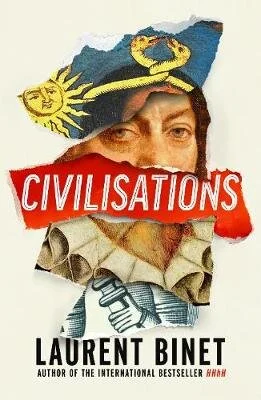The French writer Laurent Binet arrived on the international literary scene with quite a splash. Back in 2012 writers from John le Carré to Bret Easton Ellis queued up to heap praise on his debut novel, HHhH, an idiosyncratic retelling of the assassination of Reinhard Heydrich, the architect of the Final Solution.
Civilisations is no less than a reimagining of the history of the world. Vikings not only reach the Americas, they introduce the natives to iron and the wheel, so that when Columbus arrives in 1492 he finds them well armed and very dangerous. Things go so wrong that he never makes it back to Spain. Instead, 40 years later a band of Incas cross the Atlantic in the opposite direction and conquer Europe.
Binet certainly has fun. For each era he writes about he takes on the appropriate literary manner: the opening Viking episode is told as a Norse saga, all genealogical lists and heroic epithets (“granddaughter of Thorbjorg the Ship-Chested”). Columbus’s ill-fated expedition is rendered as a journal, while the bulk of the book, the Incas’ European takeover, is told in the manner of early historiography, as “The Chronicles of Atahualpa”. There are also letters, notably between Sir Thomas More and Erasmus, and a final section, “The Adventures of Cervantes”, recounted in Don Quixote-style titled chapters (“Which treats of how Providence allowed Cervantes and the Greek to escape death …”).
Then Binet has great sport recasting significant events from the period, from the Lisbon earthquake to the European debut of the potato, and remodelling historical figures, from Columbus as a naked, craven captive to Cervantes lusting after Montaigne’s wife. Naturally the Reformation is thrown off course by the sun worshippers, but in a sly twist the Incas are tolerant of other faiths. (“The wisdom of a heathen, if he is guided by God, however unwittingly, can do more for humanity than a bloodthirsty Christian,” Erasmus tells More.) They see off the Inquisition in Spain, take a dim view of Luther’s extremism and introduce agrarian reform. Under the Incas’ wise and benevolent rule Europe flourishes, so much so that their rivals, the bloodthirsty Mexicans, invade France, erecting a pyramid in the middle of the Louvre (ho ho) to make human sacrifices.
It is a novel that flatters the reader’s intellect: the more you know about the Renaissance the more you’ll recognise. Here’s Henry VIII falling out with More about taking England over to sun worship and there’s Pizarro popping up as Inca aide-de-camp rather than conquistador. The problem is that it feels like showing off rather than anything properly considered. There could be a point to this counterfactual history, giving us a consideration of Christianity seen through the eyes of baffled outsiders who find it difficult to accept that a powerful god “let his son be nailed to a cross by the men he was trying to help”, or thinking through how Europe might have developed had tolerance prevailed rather than religions at war. But these lines are never properly pursued; instead Binet gives in to the temptation of the easy joke — an artist named Michelangelo makes a sculpture of Viracocha, creator of celestial bodies; Henry VIII dissolves the monasteries and replaces them with Temples of the Sun; Francis I has his heart ripped out on that Louvre pyramid. So yes, it’s fun, but it’s not substantial. Still, perhaps that’s enough.

